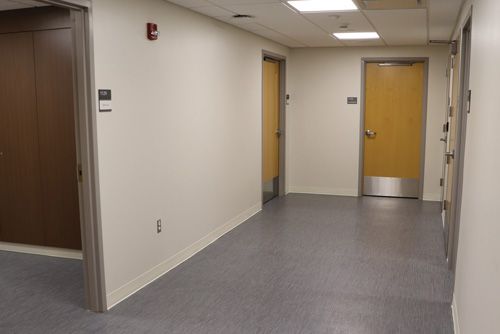Wall-opening rules for fire-rated construction

3 years, 4 months ago
Note: This is Part 2 in a series:
By Ellen McCulley
Licensed Architect, Nelson Design, Inc.
In Part 1 of this series (Winter 2021-22 issue), I discussed building codes that are typically applicable for fire walls, as well as fire and smoke barriers and partitions in healthcare facilities. I also went into detail on the various types of fire-rated construction and their respective uses in both the International Building Code (IBC) and NFPA 101 Life Safety Code. Part 2 covers requirements for window and door openings in fire-rated construction.
IBC, 2015 edition
Opening Protectives in Fire Resistance-Rated Assemblies
The 2015 edition of the IBC summarizes requirements for fire door assemblies in Table 716.5 based on the type of wall they’re in (fire wall, fire barrier, fire partition, etc.) and the corresponding rating of the wall. The table delineates the fire assembly rating of the door, the maximum door vision size, and the required rating of the vision panel and/or sidelight/transom panel. These doors are typically required to be self-closing.
Maximum Size Opening
The IBC also designates a maximum size of opening for both fire walls and fire barriers. For fire walls, each opening cannot exceed 156 square feet and the aggregate width of openings at any floor level cannot exceed twenty-five percent of the length of the wall. For fire barriers, openings are limited to a maximum aggregate width of twenty-five percent of the length of the wall and a single opening cannot be more than 156 square feet. These requirements have a few exceptions, so refer to the code for more information.
Smoke Barriers
As discussed in Part 1, smoke barriers separate buildings into smoke compartments. The general rule is those doors need to be fire-rated assemblies protected in accordance with IBC section 716.5 and be self-closing. However, there are two major things to note for cross-corridor doors in Group I-1, Group I-2, and ambulatory care facilities. The first is an exception from meeting 716.5 if they meet the following requirements:
- Doors shall be close-fitting within operational tolerances;
- Doors shall not have a center mullion or undercuts greater than ¾ of an inch, louvers, or grills;
- Doors shall have head and jamb stops, astragals or rabbets at meeting edges;
- Positive latching devices are not required where permitted by door manufacturer’s listing.
The second item of note is cross-corridor doors in Group I-2 and ambulatory care facilities must be automatic-closing by smoke detection and have a vision panel with fire-protected glazing and frame.
Smoke Partitions
Smoke partitions are utilized in Group I-2 corridors. Windows in smoke partitions are not limited in size, but shall be sealed to resist the passage of smoke. Therefore, they must be fixed glazing or automatic-closing upon the activation of smoke detectors. Doors in smoke partitions do not require a fire resistance rating. Hospital corridor doors do not require closers, however, they must be smoke- and draft-control doors.
NFPA 101 Life Safety Code, 2012 edition
Opening Protectives in Fire Resistance-Rated Assemblies
Table 8.3.4.2 in the NFPA 101 2012 edition is very similar to the IBC Table 716.5. Please refer to these tables for the detailed requirements. Fire door and window assemblies must meet the requirements of NFPA 80, Standard for Fire Doors and Other Opening Protectives. These doors are also typically required to be self-closing.
Maximum Size Opening
The total combined area of glazing in fire-rated window and door assemblies in fire barriers shall not exceed twenty-five percent of the area of the fire barrier that is common to any room.
Smoke Barriers
NFPA does not require a fier-rated assembly or latching hardware for smoke barrier doors in new healthcare occupancies; however, the following is required:
- The doors shall be self-closing or automatic-closing;
- Stops shall be required at the head and sides of door frames;
- Rabbets, bevels, or astragals shall be required at the meeting edges of pairs of doors;
- Center mullions shall be prohibited.
Note: Part 3 will cover penetrations and duct openings in fire resistance-rated assemblies.

About the Author
Ellen McCulley graduated magna cum laude with a Bachelor of Architecture degree from Iowa State University, where she received the Pella Architectural Award from the Department of Architecture in the College of Design. She is a registered architect in Iowa, Illinois, Nebraska and Missouri, and joined Nelson Design, Inc., a wholly owned subsidiary of Carl A. Nelson & Company, in 2012.
How to obtain code review for your project or facility
Carl A. Nelson & Company is available to help clients address code-related issues in their facilities. Call (319) 754-8415 and ask for Ellen McCulley. Review past installments of Decoding the Code at www.carlanelsoncoconstruction.com/decoding-the-code/